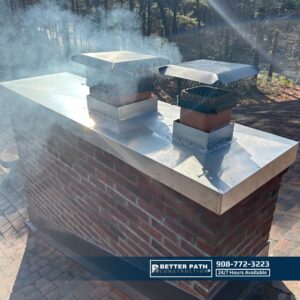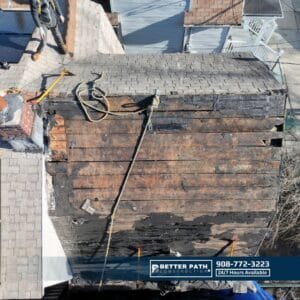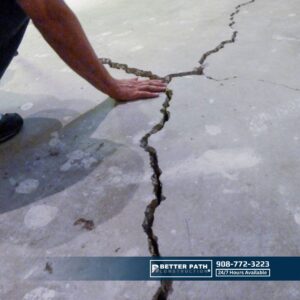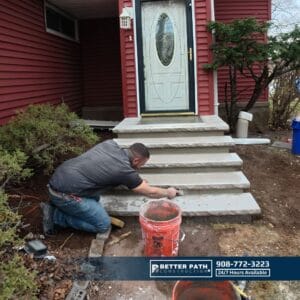If you’re asking, “What is the standard size for concrete steps?” the answer lies in building codes that prioritize safety and accessibility. In the U.S., including New Jersey, standard riser height (the vertical part) is typically 4 to 7.75 inches, with tread depth (the horizontal part) at least 10 to 11 inches, and overall width a minimum of 36 inches. These dimensions ensure comfortable, safe use while preventing trips. At Better Path Construction LLC in Little Falls, NJ, we’ve built countless steps adhering to these standards across New Jersey neighborhoods, delivering durable results that meet local codes. This guide breaks it down further, helping you plan your project effectively.
Understanding the Standard Size for Concrete Steps
When homeowners search for “What is the standard size for concrete steps?” they’re often planning a build or repair and want to ensure compliance and safety. To start, standard sizes are dictated by codes like the IRC, which New Jersey adopts with minor amendments. For instance, riser heights should not exceed 7.75 inches maximum and 4 inches minimum, while tread depths must be at least 10 inches. This balance promotes a natural stride, reducing fatigue and fall risks.
However, these aren’t one-size-fits-all. In commercial settings, the International Building Code (IBC) might require slightly different specs, like a maximum 7-inch riser and 11-inch tread. At Better Path Construction LLC in Little Falls, NJ, we always measure site-specific needs, such as slope and usage, to customize within these guidelines. For example, in older New Jersey homes, we often adjust for uneven terrain while staying code-compliant.
Why focus on these dimensions? Because improper sizing leads to accidents, statistics show falls on stairs cause over 1 million injuries annually in the U.S., per the National Safety Council. Our local experience serving areas like Paterson and Clifton emphasizes precision to avoid such issues.
Variations in Standard Sizes Based on Project Type
Importantly, variations exist depending on residential versus commercial use. For residential concrete steps, the IRC allows risers up to 7.75 inches, but we recommend 6-7 inches for comfort in New Jersey’s varied weather. Commercial steps, under IBC, cap risers at 7 inches and require treads of 11 inches minimum.
Additionally, width can vary: 36 inches minimum for homes, but 44 inches between handrails for multi-story public stairs. In our projects across Essex County, we’ve seen how wider steps enhance accessibility, especially for families or those with mobility needs.
How to Measure and Plan for Concrete Steps
Beyond knowing “What is the standard size for concrete steps?” measuring accurately is key to a successful installation. Start by calculating the total rise (vertical distance) and run (horizontal distance). Divide the rise by your desired riser height (e.g., 7 inches) to determine the number of steps. Then, ensure each tread meets the 10-11 inch depth.
For example, if your total rise is 28 inches, four 7-inch risers work perfectly. Add landings if the run exceeds 12 feet for safety. At Better Path Construction LLC, we use laser levels for precise measurements in Little Falls, NJ, accounting for soil settlement common in the region.
This planning prevents over- or under-sizing, which can void warranties or fail inspections. We also factor in handrail heights (34-38 inches) and guardrails for drops over 30 inches.
Step-by-Step Guide to Measuring Your Space
To make it simple, follow these steps:
- Measure the total vertical rise from ground to door threshold.
- Choose a riser height between 4-7.75 inches; divide total rise by this to find step count.
- Ensure tread depth is 10-11 inches; multiply by steps for total run.
- Check width: At least 36 inches clear.
This approach, honed from our New Jersey projects, ensures your steps fit seamlessly.
Building Codes and Regulations for Concrete Steps in New Jersey
In addition, New Jersey follows the IRC and IBC, with state-specific rules under NJAC 5:23. For concrete steps, footings must be at least 42 inches deep to combat frost heave, common in our winters. Risers max at 7.75 inches, treads min 10 inches, and handrails are required for three or more risers.
Furthermore, concrete must reach 2,500-5,000 PSI compressive strength. At Better Path Construction LLC, we’ve handled permits and inspections in Montclair and beyond, ensuring compliance to avoid fines up to $2,000.
Local townships may add requirements, like railings for two risers in some areas. Always consult pros for site-specific advice.
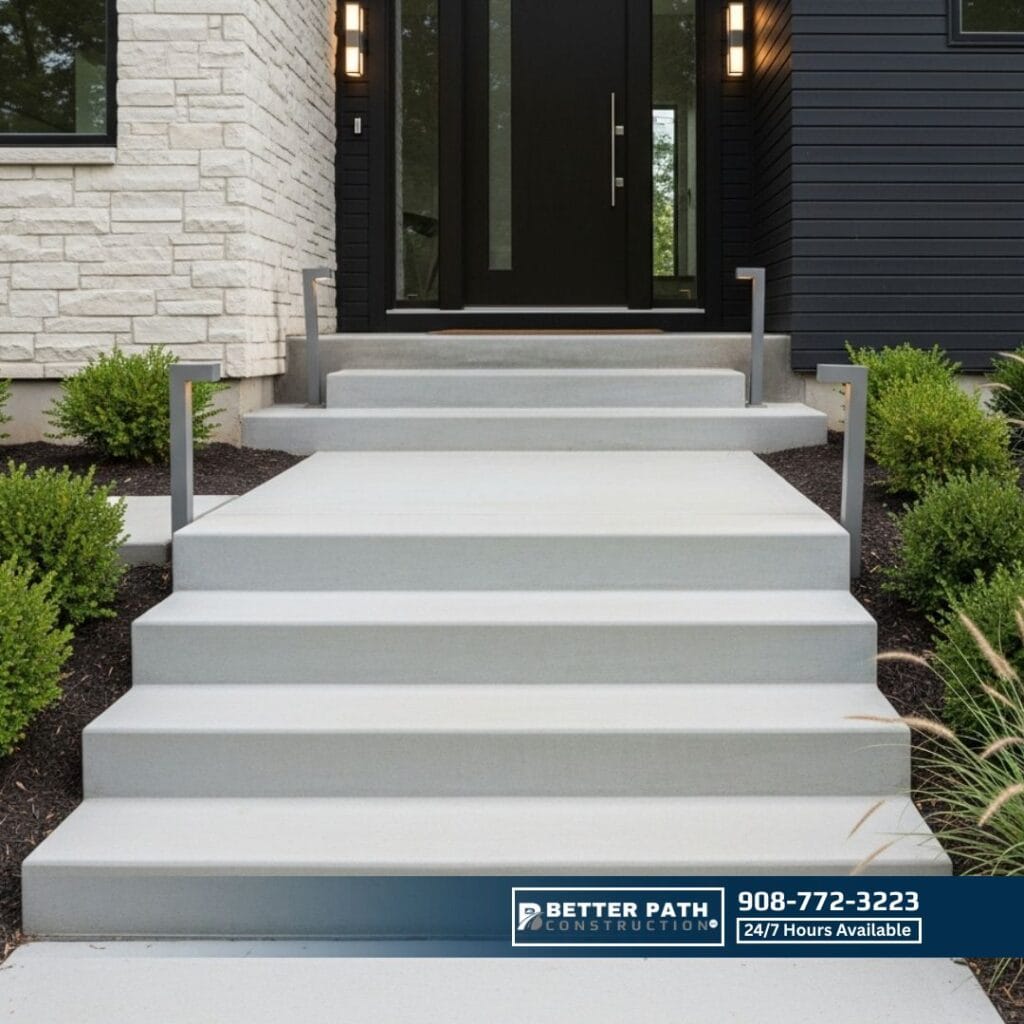
Common Mistakes to Avoid When Building Concrete Steps
Although standards are clear, mistakes happen. For instance, ignoring site prep leads to settling; always compact soil and add gravel base. Another error: Uneven risers varying more than 3/8 inch, causing trips.
Additionally, using the wrong concrete mix weakens steps-opt for 4,000 PSI for exteriors. Overwatering during pouring causes cracks; maintain proper slump. Skipping reinforcement, like rebar in wider steps, is risky too.
Tips from Local Experience in New Jersey
In Little Falls, NJ, freeze-thaw cycles demand air-entrained concrete. Moreover, we cure slowly with blankets in cold weather, a tip from years of Passaic County projects.
Statistics and Trends in Concrete Step Construction
Interestingly, concrete steps are booming: The U.S. precast concrete market hit $19.77 billion in 2023, growing 6% annually. Installation costs average $3,500, ranging $1,000-$6,000 in NJ. Trends show a 5.9% annual rise in precast demand to $18.5 billion by 2026.
In North America, cast-in-place concrete flooring grew to $4.3 billion in 2023, up 5.4% CAGR. New Jersey’s harsh weather boosts high-strength mixes.
Expert Insights on Standard Sizes for Concrete Steps
Experts stress uniformity. As one notes, “The riser height shall be not more than 7 3/4 inches… The greatest riser height within any flight of stairs shall not exceed the smallest by more than 3/8 inch.” —From ICC codes.
Another expert advises, “Stairways shall be not less than 36 inches in clear width,” emphasizing safety. —IRC guidelines.
A third states, “Individual riser height = 7 inches… Individual width = 11 inches,” for optimal design. —Concrete construction pros.
At Better Path Construction LLC, we echo this for NJ climates.
Answering Related Reader Questions
How long do concrete steps last? 30-50 years with maintenance. Can I DIY? Possible, but pros ensure codes. What’s the best height? 7 inches for comfort.
FAQs
Check risers (4-7.75 inches), treads (10+ inches), and width (36+ inches). If unsure, contact Better Path Construction LLC in Little Falls, NJ, for an assessment.
Poured is site-customized; precast is factory-made for speed. We offer both in New Jersey.
Yes, for most projects-check local codes to avoid issues.
Conclusion
In summary, grasping “What is the standard size for concrete steps?” from 7.75-inch max risers to 36-inch widths ensures safe, compliant builds. With NJ-specific insights, stats showing market growth, and expert advice, you’re set. At Better Path Construction LLC in Little Falls, NJ, we bring expertise to every project. Ready for the steps that last? Call (555) 123-4567 or visit our site for a free quote. Let’s build something great together!






